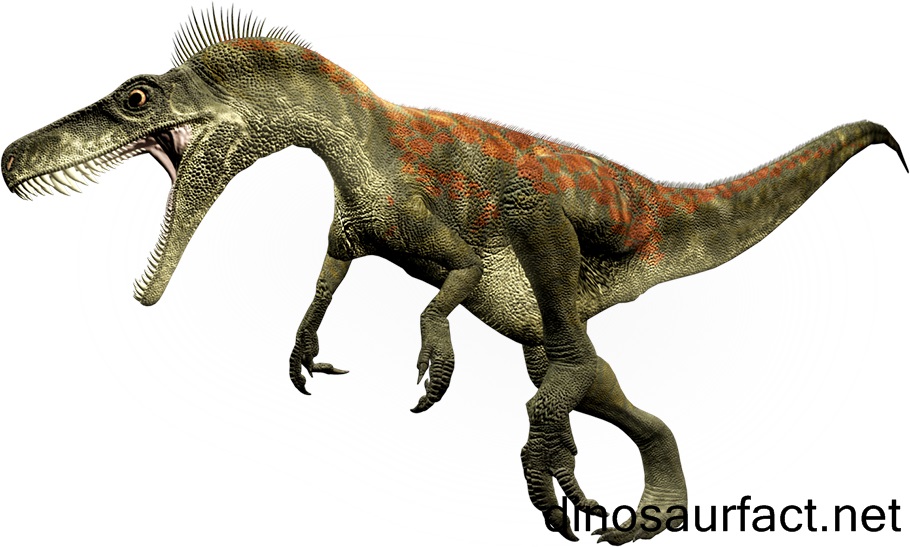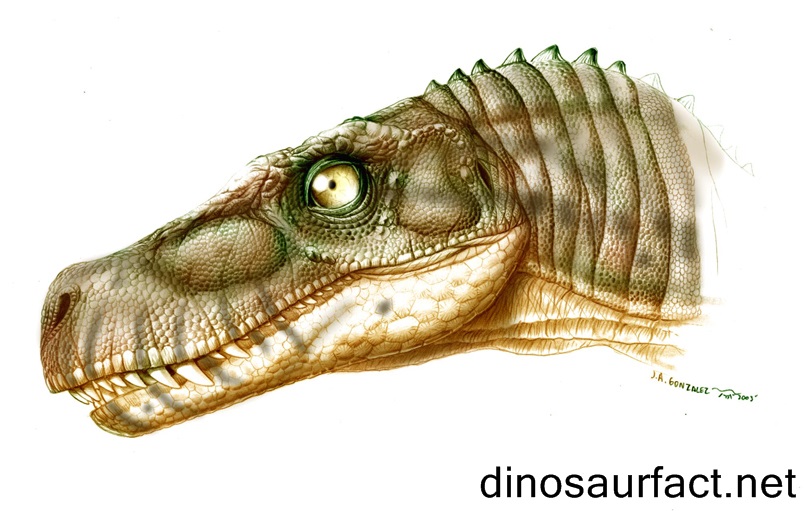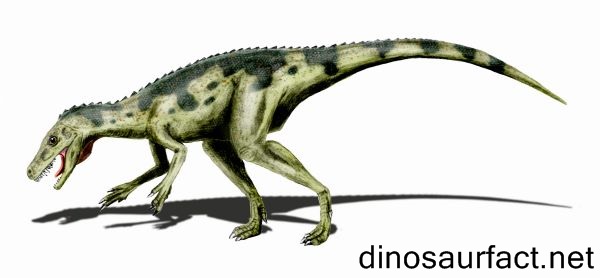 Click to visit the previous dinosaur bio
Click to visit the previous dinosaur bio
 |
|
 |
|
Kingdom: Animalia
Phylum: Chordata
Class: Sauropsida
Superorder: Dinosauria
Order: Saurischia
Suborder: Theropoda
Family: Herrerasauridae
Genus: Herrerasaurus
 |
|
 |
|
 |
|

The name Herrerasaurus means Herrera's Lizard. It was named after the rancher who first discovered the fossils. The Herrerasaurus is one of the earliest dinosaurs, having lived approximately 231.4 million years ago (mya). It is believed to have roamed the woodlands of what is now the country of Argentina.
Discovery of Fossils
The Herrerasaurus fossils were first discovered by Oswald Reig Victorino Herrara, an Andean goatherd who found these fossils in the outcrops in the city of San Juan in 1959. These rocks were part of the Ischigualasto formation and date from the late Ladinian to early Carnian stages of the Triassic Period. Complete Herrerasaurus fossils were not discovered till as late as 1988, when a team of Paleontologists led by Paul Sereno discovered the complete remains of the dinosaur.
The holotype PVL 2566 was discovered in the Cancha de Bochas member of the Ischigulasto Formation, San Juan. It was collected in 1961 by Herrera from sediments from the Triassic period dating around 235 to 221 million years ago. Other specimens PVL 2045 and MLP (4) 61 were discovered in 1959 and 1960 in sediments from the Norian stage, 228 to 208 million years ago. In 1961, specimen PVL 2558 was discovered by Scaglia followed by other Herrerasaurus specimens in 1990, also from the Carnian beds of the Cancha De Bochas member.
The Ischigualasto formation
The Ischigualasto formation from Argentina is a Late Triassic Rock formation belonging to mainly the Carnian age. Some of the oldest dinosaur skeletal remains were found in the formation. The Ischigualasto formation is famous for being the only known formation where almost the entire Triassic is presented in a series of undisrupted rock deposits, making it an important paleontological ground.
The formation is considered to have been a volcanically active floodplain with heavy rainfall. Out of the many deposits of fossils from the Carnian age, dinosaur fossils constitute only six percent. This suggests that the Carnian age was not dominated by dinosaurs but by other non-dinosaurian creatures.
Physical and Anatomical Features
The Herrerasaurus was a bipedal creature. It had a long tail and a comparatively small skull. It is estimated to have been three to six meters in length. The height up to the hip was more than 1.1 meters or 3.3 feet. The weight of the creature is estimated to be approximately around 210-350 kilograms.
The skull of the Herrerasaurus was long and narrow. It was more like the Archosaurs than it resembled later dinosaurs. In a long specimen, the skull measured up to 1.8 feet in length whereas shorter skulls measured about 30 centimeters/ a feet long. It had five skull openings, out of which two were for eyes and nostrils. Two ant orbital fenestrae and a pair of tiny, slit-like holes called promaxillary fenestrae were placed between the eyes and nostrils.
The jaw of this dinosaur had a flexible joint which could slide back and forth. This cranial development is rare among dinosaurs although it does manifest itself in some lizards. Jaws had large serrated teeth. The Herrerasaurus had a long, slender and flexible neck.
The dinosaurs forelimbs were not even half the length of its lower limbs. The forearm and upper arms were short while the hand was elongated. The first two fingers along with the thumb had curved claws. The dinosaur was fully bipedal with short thighs and large feet. The foot, despite having 5 toes only used the middle three for supporting the creature’s weight. The tail provided balance and also helped speed.
The pelvis of the Herrerasaurus was shaped like that of saurischian dinosaurs. It had a bony acetabulum. The pubis pointed towards the posterior end and the main hip bone, the illium was supported by two sacrals.
The Herrerasaurus had the following distinguishing features:
- Premaxilla-maxilla fenestrae were present and the ventral section of the latero temporal fenestra is more than thrice the dorsal part.
- A deeply incised supratemporal fossa extends from across the medial postorbital process, and a ridge is present on the jugal bone lateral surface.
- The presence of a circular pit on the humeral ectepicondyle.
- The ulnar condyle of the humerus is saddle-shaped.
- The hind border of the shaft on the ischium forms a right angle with the posterior border of the ilial peduncle.
- The post erodorsal denary process is somewhat slender and ribbed.
- There is a lateral depression in the sub quadrate ventral squamosal process.
- The humeral ectepicondyle is shaped like a ridge with both anterior and posterior openings.
- A forked anterior segment for articulation with the post erodorsal denary process is evident in the surangular bone.
- A deep grove separating the proximal projection of the humerus' internal tuberosity and the humeral head is evident in the fossils.
About the Herrerasaurus
The Herrerasaurus was a bipedal creature. It was a carnivore i.e. it used to eat the flesh of smaller herbivores. It was agile as can be deduced from its long legs. It was amongst the earliest dinosaurs. It preceded the time of divergence of birds and reptiles.
The Herrerasaurus also precedes the time of divergence of theropods and sauropods. It displays characteristics of a diverse number of dinosaur groups and some characteristics of Archosaurs. The Herrerasaurus is synonymous with the Ischisaurus and Frenguelisaurus genera.
Through various analytic processes the dinosaur has been classified as a basal theropod, a basal sauropodomorph, a basal saurischian or another type of Archosaur over the years. This debate ended when the remains of the other complete fossil were found.
The Herrerasaurus lived at a time when dinosaurs were not large and the earth was dominated by other species, like the Archosaurs. It was a large carnivore and represented a major turning point in the environment of the earth. The study of the Herrerasaurus is pivotal to the understanding of the evolution and divergence of dinosaurs.
The Herrerasaurus is rightfully placed at the initial branches of the dinosaurian family tree. More comparative analysis of the dinosaur can help yield more data about the ecology of the earth at the time. It can help understand why dinosaurs prevailed over other animal forms and solve many unanswered mysteries.
Index
Extinct Profiles
 Triassic Dinosaurs
Triassic Dinosaurs Jurassic Dinosaurs
Jurassic Dinosaurs Cretaceous Dinosaurs
Cretaceous Dinosaurs Pterosaurs
Pterosaurs Marine Reptiles
Marine Reptiles Dinosaur Extinction
Dinosaur Extinction